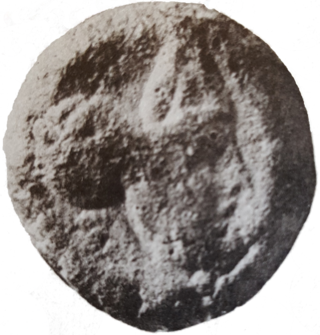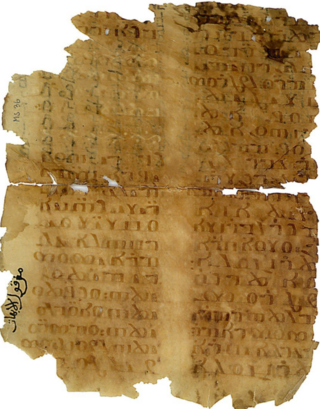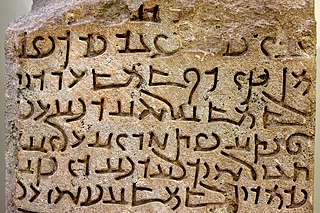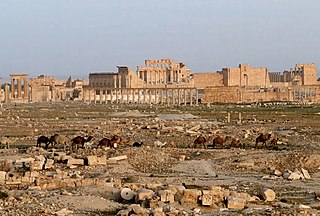
The ancient Aramaic alphabet was used to write the Aramaic languages spoken by ancient Aramean pre-Christian tribes throughout the Fertile Crescent. It was also adopted by other peoples as their own alphabet when empires and their subjects underwent linguistic Aramaization during a language shift for governing purposes — a precursor to Arabization centuries later — including among the Assyrians and Babylonians who permanently replaced their Akkadian language and its cuneiform script with Aramaic and its script, and among Jews, who adopted the Aramaic language as their vernacular and started using the Aramaic alphabet even for writing Hebrew, displacing the former Paleo-Hebrew alphabet.
Aramaic is a Northwest Semitic language that originated in the ancient region of Syria, and quickly spread to Mesopotamia, the southern Levant, southeastern Anatolia, northeastern Arabia and Sinai, where it has been continually written and spoken, in different varieties, for over three thousand years. Aramaic served as a language of public life and administration of ancient kingdoms and empires, and also as a language of divine worship and religious study. Several modern varieties, the Neo-Aramaic languages, are still spoken by the Assyrians, Mandeans, Mizrahi Jews, and in the Qalamoun Mountains. It is used as the liturgical language of a number of West Asian churches.

Septimia Zenobia was a third-century queen of the Palmyrene Empire in Syria. Many legends surround her ancestry; she was probably not a commoner and she married the ruler of the city, Odaenathus. Her husband became king in 260, elevating Palmyra to supreme power in the Near East by defeating the Sasanian Empire of Persia and stabilizing the Roman East. After Odaenathus' assassination, Zenobia became the regent of her son Vaballathus and held de facto power throughout his reign.
The Syriac language, also known as Syriac Aramaic and Classical Syriac ܠܫܢܐ ܥܬܝܩܐ, is an Aramaic dialect that emerged during the first century AD from a local Aramaic dialect that was spoken in the ancient region of Osroene, centered in the city of Edessa. During the Early Christian period, it became the main literary language of various Aramaic-speaking Christian communities in the historical region of Ancient Syria and throughout the Near East. As a liturgical language of Syriac Christianity, it gained a prominent role among Eastern Christian communities that used both Eastern Syriac and Western Syriac rites. Following the spread of Syriac Christianity, it also became a liturgical language of eastern Christian communities as far as India and China. It flourished from the 4th to the 8th century, and continued to have an important role during the next centuries, but by the end of the Middle Ages it was gradually reduced to liturgical use, since the role of vernacular language among its native speakers was overtaken by several emerging Neo-Aramaic dialects.

The Phoenician alphabet is an alphabet known in modern times from the Canaanite and Aramaic inscriptions found across the Mediterranean region. The name comes from the Phoenician civilization.

Dura-Europos was a Hellenistic, Parthian, and Roman border city built on an escarpment 90 metres above the southwestern bank of the Euphrates river. It is located near the village of Salhiyé, in present-day Syria. Dura-Europos was founded around 300 BC by Seleucus I Nicator, who founded the Seleucid Empire as one of the Diadochi of Alexander the Great. In 113 BC, Parthians conquered the city, and held it, with one brief Roman intermission, until 165 AD. Under Parthian rule, it became an important provincial administrative centre. The Romans decisively captured Dura-Europos in 165 AD and greatly enlarged it as their easternmost stronghold in Mesopotamia, until it was captured by the Sasanian Empire after a siege in 256–57 AD. Its population was deported, and the abandoned city eventually became covered by sand and mud and disappeared from sight.
The Arameans, or Aramaeans, were an ancient Semitic-speaking people in the Near East that was first recorded in historical sources from the late 12th century BC. The Aramean homeland, sometimes known as the land of Aram, encompassed central regions of modern Syria.
Suret, also known as Assyrian or Chaldean, refers to the varieties of Northeastern Neo-Aramaic (NENA) spoken by Christians, largely ethnic Assyrians. The various NENA dialects descend from Old Aramaic, the lingua franca in the later phase of the Assyrian Empire, which slowly displaced the East Semitic Akkadian language beginning around the 10th century BC. They have been further heavily influenced by Classical Syriac, the Middle Aramaic dialect of Edessa, after its adoption as an official liturgical language of the Syriac churches, but Suret is not a direct descendant of Classical Syriac.

Septimius Odaenathus was the founder king (Mlk) of the Palmyrene Kingdom who ruled from Palmyra, Syria. He elevated the status of his kingdom from a regional center subordinate to Rome into a formidable state in the Near East. Odaenathus was born into an aristocratic Palmyrene family that had received Roman citizenship in the 190s under the Severan dynasty. He was the son of Hairan, the descendant of Nasor. The circumstances surrounding his rise are ambiguous; he became the lord (ras) of the city, a position created for him, as early as the 240s and by 258, he was styled a consularis, indicating a high status in the Roman Empire.

Christian Palestinian Aramaic was a Western Aramaic dialect used by the Melkite Christian community, predominantly of Jewish descent, in Palestine, Transjordan and Sinai between the fifth and thirteenth centuries. It is preserved in inscriptions, manuscripts and amulets. All the medieval Western Aramaic dialects are defined by religious community. CPA is closely related to its counterparts, Jewish Palestinian Aramaic (JPA) and Samaritan Aramaic (SA). CPA shows a specific vocabulary that is often not paralleled in the adjacent Western Aramaic dialects.
The Western Aramaic languages represent a specific subgroup of Aramaic once spoken widely throughout the ancient Levant, predominantly in the south, and Sinai, including ancient Damascus, Nabatea, Judea, across the Palestine Region, Transjordan and Samaria. The group was divided into several regional variants, spoken mainly by the Nabataeans, Mizrahi Jews, Melkites of Jewish descent, and Samaritans. All of the Western Aramaic languages are considered extinct today, except Western Neo-Aramaic.
Old Aramaic refers to the earliest stage of the Aramaic language, known from the Aramaic inscriptions discovered since the 19th century.

Aramaic of Hatra, Hatran Aramaic or Ashurian designates a Middle Aramaic dialect, that was used in the region of Hatra and Assur in northeastern parts of Mesopotamia, approximately from the 3rd century BC to the 3rd century CE. Its range extended from the Nineveh Plains in the centre, up to Tur Abdin in the north, Dura-Europos in the west and Tikrit in the south.

The Palmyrene alphabet was a historical Semitic alphabet used to write Palmyrene Aramaic. It was used between 100 BCE and 300 CE in Palmyra in the Syrian desert. The oldest surviving Palmyrene inscription dates to 44 BCE. The last surviving inscription dates to 274 CE, two years after Palmyra was sacked by Roman Emperor Aurelian, ending the Palmyrene Empire. Use of the Palmyrene language and script declined, being replaced with Greek and Latin.

Palmyra is an ancient city in the eastern part of the Levant, now in the center of modern Syria. Archaeological finds date back to the Neolithic period, and documents first mention the city in the early second millennium BC. Palmyra changed hands on a number of occasions between different empires before becoming a subject of the Roman Empire in the first century AD.
The Bene Komare were a Palmyrene tribe who were attested as one of the main four tribes of Palmyra.

The Aramaic inscription of Laghman, also called the Laghman I inscription to differentiate from the Laghman II inscription discovered later, is an inscription on a slab of natural rock in the area of Laghmân, Afghanistan, written in Aramaic by the Indian emperor Ashoka about 260 BCE, and often categorized as one of the Minor Rock Edicts of Ashoka. This inscription was published in 1970 by André Dupont-Sommer. Since Aramaic was an official language of the Achaemenid Empire, and reverted to being just its vernacular tongue in 320 BCE with the conquests of Alexander the Great, it seems that this inscription was addressed directly to the populations of this ancient empire still present in this area, or to border populations for whom Aramaic remained the language used in everyday life.

The Temple of the Gadde is a temple in the modern-day Syrian city of Dura-Europos, located near the agora. It contained reliefs dedicated to the tutelary deities of Dura-Europos and the nearby city of Palmyra, after whom the temple was named by its excavators. The temple was excavated between 1934 and January 1936 by the French/American expedition of Yale University, led by Michael Rostovtzeff.

The Temple of Zeus Cyrius stood in the city of Dura-Europos (Syria) and The construction of the original temenos is dated by the inscriptions above its altar and on its cult reliefs to the end of the second decade of the first century after Christ. It was excavated in 1934 by a joint French-American expedition.

Odaenathus, the king of Palmyra from 260 to 267 CE, has been identified by modern scholars as the subject of sculptures, seal impressions, and mosaic pieces. His city was part of the Roman Empire, and he came to dominate the Roman East when in 260 he defeated Shapur I, the Sasanian emperor of Persia, who had invaded the Roman Empire. Odaenathus besieged the Sasanian capital Ctesiphon in 263, and although the city did not fall, the campaign led to a full restoration of Roman provinces taken by Shapur I. In the aftermath of his Persian war, Odaenathus assumed the title King of Kings, which was a challenge to the Persian monarch's claims of authority in the region. Odaenathus ruled the Roman East unopposed with imperial consent. In 267, he was assassinated alongside his eldest son Herodianus while conducting a campaign against Germanic raiders in Bithynia; he was succeeded by his son Vaballathus under the regency of the widow queen Zenobia.












